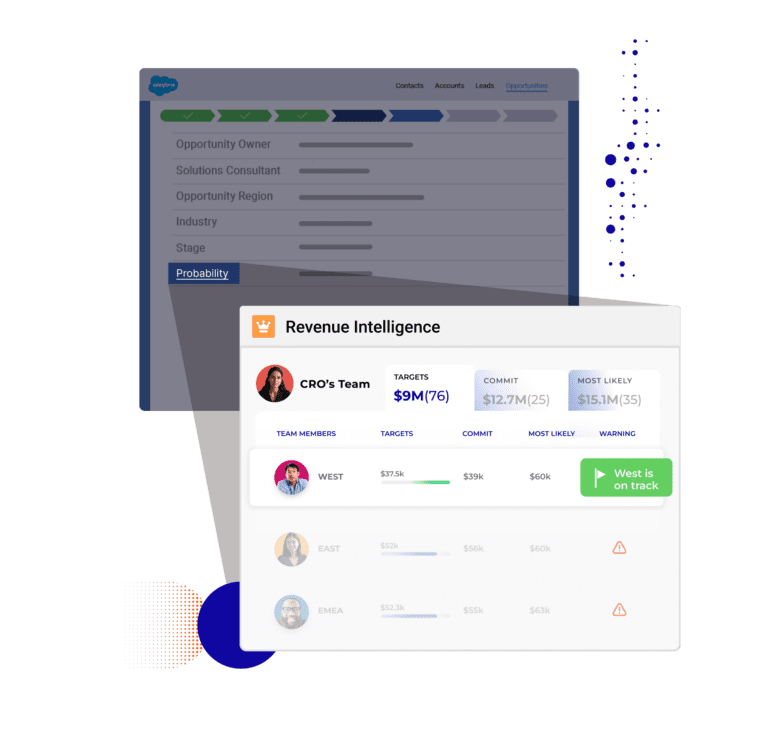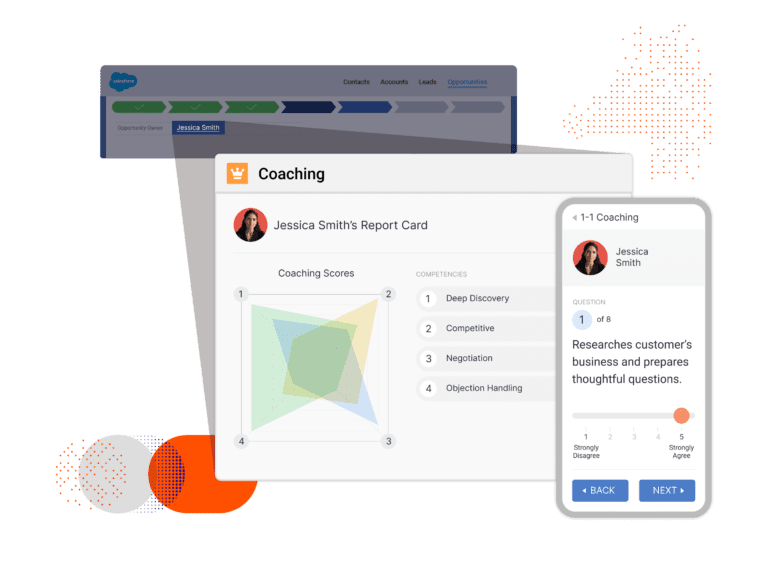In 2024, many sales organizations are focused on measuring and improving sales productivity. But what does that even mean?
What is sales productivity?
Simply put, sales productivity is how efficient and effective your sales reps are at hitting a variety of revenue milestones and goals. Of course, just because reps are making more calls and sending more emails does not mean they are necessarily progressing sales or generating revenue.
At Mindtickle, we define a sales productivity tool as anything that improves and measures the skills, will, and in-field behaviors demonstrated by reps.
That might include tools that hold reps accountable, such as email and call activity tracking; those that empower reps to better prepare for meetings and follow-up, such as Content Management Systems (CMS); and solutions that arm reps with insights that help them drive specific deals and accounts forward more effectively.
Read on to see some of the top sales productivity stats your organization must know and adapt to in 2024 & beyond.
Sales productivity stats & customer experience
- The average enterprise B2B buying group consists of between five and 11 stakeholders, who represent an average of five distinct business functions. (Gartner B2B Buying Report).
- Once you’re talking to a decision-maker, the ideal number of calls to win a sale is six. (Crunchbase)
- 80% of sales occur after the fifth call.
- The best time to make sales calls is within an hour of receiving their initial inquiry. (Callhippo)
- Only 7 percent of companies respond within five minutes of a prospect’s form submission. But that can hurt you—35 to 50 percent of sales go to the company that responds first.
- Although the number of buying interactions increases slightly every year (e.g., from 16 to 17 between 2017 and 2019), the number of buying interactions during the pandemic jumped from 17 to 27. – (Forrester’s 2021 B2B Buying Study).
- 86% of sellers say they lost or delayed at least one deal in the past year because a key client stakeholder left the company. (LinkedIn State of Sales Report)
According to LinkedIn
- Almost 40% of sellers have closed deals over $500,000 without ever meeting the customer face to face. (LinkedIn)
- In B2B sales, 84% of buyers start the purchasing process with a referral. (Harvard Business Review)
- Peer recommendations influence 90% of all B2B buying decisions. (Harvard Business Review)
- Referred customers have an 18% percent lower churn rate than customers acquired through other sources.
Referred customers have a
- When consumers are acquired through referrals, they have a 37% higher retention rate, and they’re four times more likely to make a purchase.
- 81% of sales reps say buyers are increasingly conducting their own research before reaching out. (Salesforce)
- 87% of business buyers expect sales reps to act as trusted advisors. (Salesforce)
- Buyers are 2.8 times more likely to make a purchase if there is a high level of information consistency between the vendor’s website and the vendor’s sales reps. (Gartner B2B Buying Report)
Sales productivity stats & rep time management
- Sales reps spend a mere 28% of their week actively selling. (Salesforce )
- 82% of top-performing salespeople always perform research prior to reaching out to prospects, compared to 49% of other sellers. (LinkedIn)
- Three-quarters of sellers are doing “significantly more” or “more” research in the past 12 months. (LinkedIn)
- On average, it takes eight cold calls to reach a prospect. (Crunchbase)
On average, it takes
- Call answer rates peak between 10am and 11:30am. (Revenue.io, formerly ringDNA)
- A single outbound sales rep should average 60 calls per day. (Revenue.io, formerly ringDNA)
- Sales teams that prioritize social selling are 51% more likely to reach their sales quota. (LinkedIn)
Sales productivity stats for sales managers
- 67% of sales managers say that overseeing a remote sales team is more challenging than they anticipated. (LinkedIn State of Sales Report).
- The majority (71.4%) of sellers believe 50 percent of the prospects they speak with aren’t a good fit for the product or service they’re selling.
Sales productivity stats for sales enablement
- Long-term training is important and—unfortunately—overlooked. 85 percent of reps report being coached on closing open deals, but only 24 percent report being coached on long-term skills.
- Only 26% of sales professionals say they receive 1:1 coaching from their managers at least weekly. (Salesforce)
- 90% of content is unused by sales. (American Marketing Association).
Sales productivity & technology usage
- 63% of organizations have ten or more tools to support sales activities – but sellers incorporate fewer into their daily workflows. (Mindtickle).
- 76% of organizations expect AI to significantly affect their day-to-day jobs over the next year. (Mindtickle)
Mindtickle research found that
- The most common use cases for AI to drive sales productivity include analyzing call recordings (58%), helping reps get answers to customer questions in the flow of work (54%), and serving up recommendations for training (51%). (Mindtickle)
- Gartner predicts that by 2028, 60% of B2B seller work will be executed through conversational user interfaces via generative AI sales technologies.
How to improve your sales team using these statistics:
How to improve your sales team using these statistics
Based on these stats, we’ve got some recommendations for you below. Here are some of the top ways to apply these stats to put changes in place that actually improve your sales team’s performance and productivity.
- Roll out an enablement program around multi-threading to different personas. Make sure every rep understands how to drive urgency and qualify every persona. Consider creating a laminated “desk buddy” for each persona to help reps multi-thread.
- Use a revenue intelligence or conversation intelligence tool to score deal health and know with data if reps have engaged the right title and number of contacts.

- Refine your BDR process so that you are picking up the phone and reaching out to leads who visit your website right away. Consider an automated and highly personalized chatbot.
- Build a playbook for what reps do when a champion leaves the company, which is more likely to happen in the current economy.
- Put a really detailed referral program in place to incentivize reps to ask for customer referrals and customers to provide them.
- Build a playbook around when/how reps can add value with each persona they engage.
- Automate note-taking and account hand-offs with conversation intelligence
- Ensure you have an up-to-date cold calling process and playbook in place – cold calling is NOT dead!
- Implement MEDPIC, BANT, or another sales methodology to ensure sales reps are qualifying prospects. Track that this process is being completed in your CRM.
- Provide sales managers with detailed sales manager training on how to coach. Measure how many calls and deals they review and track that coaching was complete.


- Go beyond deal coaching to focus on skill development. In month one, focus on discovery. In month two, focus on perfecting the demo and telling powerful customer stories. In month three, focus on differentiating and handling objections.
- Put a tool in place to ensure top-rated and most viewed/shared content is easy for reps to find. Make sure reps can provide two-way feedback on the content you’ve created so that you know what is truly driving deals forward and what reps find useful.
- When possible, consolidate tools and prioritize tools that enable you to automate processes or access voice of customer insights that will help your reps uncover deal risks, better compete, and win more
Sales Productivity in Mindtickle
Ready to see how Mindtickle can help you get every seller more productive and crushing quota every quarter?
Request a DemoThis post was originally published in January 2023 and updated in January 2024.







